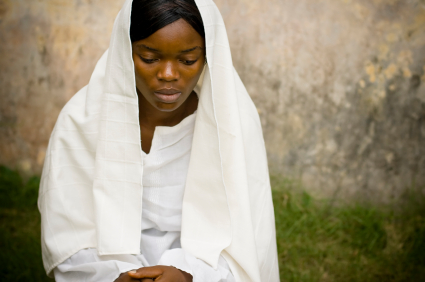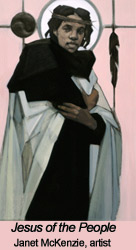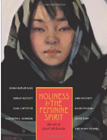|

SECOND SUNDAY OF ADVENT
CULTURAL RESOURCES
Sunday, December 5, 2009
Ray A. Owens, Guest Cultural Resource Commentator
Affiliate Assistant Professor of Ethics and Black Church Studies, Phillips Theological Seminary and Senior Pastor, Metropolitan Baptist Church, Tulsa, OK
I. Historical Section
Thematically, the second Sunday of Advent addresses the Christian claim that Christ is “the way.” The tradition of lighting the four Advent candles, one for each Sunday leading to Christmas, distinguishes the second candle as “the candle of the way.” In so doing, this liturgical practice proclaims Christ as the light that illumines the way out of evil and destruction. While the basic themes of the Advent season—active waiting, longing, and anticipation—remain central, they are coupled, on this second Sunday of the season, with the challenge to prepare for the way of Christ. In our text for today, we learn that no one did this more than Mary, his mother.
The promise intrinsic to Advent, that Christ will light and lead the way out of suffering and oppression, comes with a divine call to participate in the process of deliverance. Therefore, this liturgical moment should be marked by careful preparation intended to make us ready to receive, recognize, reinforce and follow the way of Christ. Additionally, recognition of the important role that women have always played in the process of African American deliverance is noteworthy today and beyond.
II. Cultural Response
The Second Sunday of Advent comes as a telling reminder that Christmas day is rapidly approaching. It is just about this time in the season that many people begin to ask that frightening question, “Are you ready for Christmas?” It’s a question that many of us find intimidating and possibly even intrusive. We’ve all asked the question, and we’ve all been asked the question. Yet, for some, the question exposes our propensity for procrastination and lack of preparation.
Usually when we are asked this question we begin to list a litany of items that remain on our Christmas shopping and to-do lists. A typical response might play out something like this: “Well, no. I still need to find a pink Nintendo DSI for my daughter. Wal-Mart only has blue and black ones in stock and the pinks ones, I’m told, are ‘to die for.’ I have yet to pick up that action figure for my son. Someone told me they have eight left at the Toys ‘R’ Us on the other side of town. I need to get my secret Santa gift for the job, and I’m still trying to figure out how many people we are expecting for Christmas dinner!”
Sadly, preparing the way of the Lord is often reduced to preparing shopping lists, grocery lists and guest lists. To be sure, there is a desperate need to redirect Christians toward practices that better reflect preparations for the way of Christ. In effect, we need a new set of responses to and expectations around the question, “Are you ready for Christmas?” What does it mean to be ready for Christmas when we view this season in the light of a savior who lights the way out of darkness? How does one prepare for the coming of such a light? How can congregations and communities participate in the way-making work of Jesus the Christ?
The significance of the North Star in African American culture offers a useful image for thinking about the meaning of this liturgical moment for black people. For enslaved Africans in the antebellum south, the North Star served as a light illuminating the way out of the darkness of slavery and into the light of freedom. Historical reports document countless cases of runaway slaves who traveled by night using the light of the North Star as their compass.
The connection between the light of the North Star and the right way toward freedom opens up powerful theological possibilities for Advent. As the God of liberation, Jesus lights the way that leads to our freedom. Freedom, therefore, requires our participation. Like our freedom-seeking foreparents who risked life and limb chasing the North Star, we must pursue the path that reflects the light of the Christ whose coming we celebrate this season. This liturgical moment must be about the search and preparation for the way of Christ; the way that that leads from light to darkness, from bondage to freedom, from brokenness to wholeness, from disunity to community, from death to life. We are only ready for Christmas to the extent we are prepared to follow in the way of Jesus, the light.
III. Songs for Second Sunday of Advent
The three gospel songs below reinforce the themes of Jesus as the way and Jesus as the light. The first selection proclaims that Jesus Christ is the way! It acknowledges the sense of mystery that surrounds Jesus’ coming, while at the same time proclaiming an unwavering faith in Jesus’ return. In the song by Hezekiah Walker, the image of Jesus as a way-maker offers another twist on the theme of the way. Not only is Jesus the way, but also Jesus makes a way in the midst of our darkness. Finally, the popular gospel piece by V. Michael McKay speaks to the light that Jesus brings into a dark world. More specifically, this song points out the possibilities that occur when we allow the light of Jesus to shine in our lives. We become agents of the way-making work of Jesus as we open ourselves to the light’s power and presence.
Jesus Christ Is the Way
When I think about the hour
Then I know what I must do.
No man knows the day nor the hour.
May be morning, night or noon.
But just rest assure
Time will be no more
He is coming back soon
Then I will open up my heart
To everyone I see
And say Jesus Christ is the way
Then I will open up my heart
To everyone I see
And say Jesus Christ is the way1
He Made a Way
Chorus:
He made a way just for me.
He opened doors I could not see.
He made a way just for me.
He opened doors I could not see.
He brought me out, out of darkness,
And through the word I can see, see.
Jesus, He saved me,
Jesus, He saved me,
I’m so glad that Jesus made a way for me.
Vamp:
Jesus, He saved me.
Jesus, He saved me.
Jesus, He saved me.
Jesus, He saved me.
I’m so glad that Jesus made a way for me.2
Jesus Is the Light
Chorus 1:
Jesus is the light
that shineth in me, that shineth in me.
Jesus is the light
that shineth in me, that shineth in me.
Chorus 2:
He’ll show up in me.
He’ll show up in me.
He’ll show up in me.
He’ll show up in me.
Verse 1:
If I walk the way He wants me to walk,
(He’ll show up in me, He’ll show up in me).
If I talk the way God wants me to talk,
(He’ll show up in me, He’ll show up in me).
If I live the way God wants me to live,
(He’ll show up in me, He’ll show up in me).
If I do what He wants me to do,
(He’ll show up in me, He’ll show up in me).
Vamp 1:
Jesus, Jesus,
Jesus, Jesus
Vamp 2:
Show up, show up,
Show up, show up
Vamp 3:
Rise up, rise up
Rise up, rise up
Vamp 4:
Higher, higher
Higher, higher.3
IV. Women, Art and Advent

In 1999, Janet McKenzie’s interpretation of Christ, Jesus of the People, which is a painting of Christ as an African American with dreadlocked hair, won the National Catholic Reporter’s global competition for a new image of Christ.4 She became quite well-known after painting this image because her depiction of Jesus as a “strongly masculine” black male who also embodied a “female gentleness and compassion” … went against the tradition of depicting Jesus as “more … white, male and beatific.”5
 In her latest book, Holiness and the Feminine Spirit: The Art of Janet McKenzie, McKenzie features Jesus of the People and twelve other images. The book also contains articles written by well-known African American women including Dr. Katie Cannon of Union Presbyterian Seminary, one of the mothers of the Womanist Movement; Dr. Diana Hayes, who prepared today’s lectionary commentary; and Sister Anita Baird, DHM, who is the founding director of the Archdiocese of Chicago’s Office for Racial Justice. Many of these articles provide a unique approach to twenty-first century Christology from an African American female perspective. Several can be used in Bible study or even in Sabbath School or Sunday school classes. They may be particularly useful for teaching youth and young adults given the great visual images. In her latest book, Holiness and the Feminine Spirit: The Art of Janet McKenzie, McKenzie features Jesus of the People and twelve other images. The book also contains articles written by well-known African American women including Dr. Katie Cannon of Union Presbyterian Seminary, one of the mothers of the Womanist Movement; Dr. Diana Hayes, who prepared today’s lectionary commentary; and Sister Anita Baird, DHM, who is the founding director of the Archdiocese of Chicago’s Office for Racial Justice. Many of these articles provide a unique approach to twenty-first century Christology from an African American female perspective. Several can be used in Bible study or even in Sabbath School or Sunday school classes. They may be particularly useful for teaching youth and young adults given the great visual images.
V. Advent Prayer
In a collection of prayers written while he was a professor at Atlanta University, W.E.B. DuBois poignantly captured the spirit of the Advent season. His prayer seeks a turn to the ideals and hope that attend the birth of Jesus. He laments over the deficit of Christ-like virtues in the world and prays for the day when we will be guided by the true will and way of Jesus Christ. Below is one prayer from this collection. It offers an excellent cultural and historical resource for our liturgical moment.
A Prayer by W.E.B. Dubois
In the solemn silence of this Thy Holy night, O Heavenly Father, let the Christ spirit be born anew in this our home and in this land of ours.
Out of the depths of selfishness and languor and envy, let spring the spirit of humility and poverty, of gentleness and sacrifice—the eternal dawn of Peace, good-will toward men.
Let the birth-bells of God call our vain imaginings back from pomp and glory and wealth—back from the wasteful warships searching the seas—back to the lowly barn-yard and the homely cradle of a yellow and despised Jew, whom the world has not yet learned to call Wonderful, Counselor, the Mighty God, the Everlasting Father, and the Prince of Peace. Amen.6
The next is a poem prayer adapted by members of the Lectionary team from a prayer created by Ormonde Plater, a deacon of the Diocese of Louisiana (The Episcopal Church).
Second Sunday of Advent
| Leader: |
As we prepare the way of the Lord, let us offer prayers to God who will baptize us with Spirit and fire. |
| The People: |
For the peace of the world, and for our unity in Christ.
Come, O Lord, and save us. |
| Leader: |
For all bishops, for the presbyters, for all pastors, for the deacons and all who minister in Christ and are the holy people of God.
Come, O Lord, and save us. |
| The People: |
For the Church throughout the world and the faithful in every place.
Come, O Lord, and save us. |
| Leader: |
For the leaders of the nations and all in authority.
Come, O Lord, and save us. |
| The People: |
For justice, tolerance and freedom among peoples of the earth.
Come, O Lord, and save us. |
| Leader: |
For travelers, for mis-treated children, for the sick and the suffering, for the hungry and the oppressed, and for those in prison.
Come, O Lord, and save us. |
| The People: |
For the dying and the dead.
Come, O Lord, and save us.
For our deliverance from affliction, strife, and need.
Come, O Lord, and save us. |
| Leader: |
Joining our voices with the Blessed Virgin Mary and with all the saints especially those who endured the Middle Passage, let us offer ourselves and one another to the living God through Christ. |
| All: |
To you, O Lord: O Root of Jesse, who rises as a signal among all peoples, in whose presence rulers stand silent and nations bow in worship, come and deliver us without delay. Glory to you forever. Amen. |
Notes
1. Hawkins, Walter. “Jesus Christ Is the Way.” Lyrics Mania. Online location: http://www.lyricsmania.com accessed 27 August 2009
2. Walker, Hezekiah. “He Made a Way.” KOvideo. Online location: http://www.kovideo.net/lyrics accessed 27 August 2009
3. McKay, V. Michael. “Jesus Is the Light.” Gospel Music Lyrics. Online location: http://www.music-lyrics-gospel.com accessed 15 March 2009
4. McKenzie, Janet. Jesus of the People. Online location: http://www.janetmckenzie.com/joppage1.html accessed 15 March 2009
5. Eby, Lois. Quoted from Vermont Public Radio. Janet McKenzie.com. Online location: http://www.janetmckenzie.com/joppage1.html accessed 15 March 2009
6. DuBois, W.E.B. Prayers For Dark People. Ed. Herbert Aptheker. Amherst, MA: University of Massachusetts Press, 1980. p. 15.
|